George IV of the United Kingdom
| George IV | |||||
|---|---|---|---|---|---|
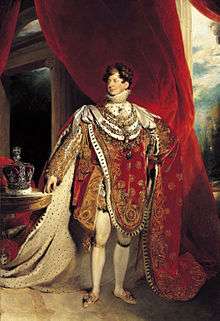 Coronation portrait by Sir Thomas Lawrence, 1821 | |||||
| King of the United Kingdom and Hanover (more...) | |||||
| Reign | 29 January 1820 – 26 June 1830 | ||||
| Coronation | 19 July 1821 | ||||
| Predecessor | George III | ||||
| Successor | William IV | ||||
| Prime Ministers | |||||
| Born |
12 August 1762 St James's Palace, London | ||||
| Died |
26 June 1830 (aged 67) Windsor Castle, Berkshire | ||||
| Burial |
15 July 1830 St George's Chapel, Windsor Castle | ||||
| Spouse | Caroline of Brunswick | ||||
| Issue | Princess Charlotte | ||||
| |||||
| House | Hanover | ||||
| Father | George III | ||||
| Mother | Charlotte of Mecklenburg-Strelitz | ||||
| Religion | Anglican | ||||
| Signature |
 | ||||
George IV (George Augustus Frederick; 12 August 1762 – 26 June 1830) was King of the United Kingdom of Great Britain and Ireland and of Hanover following the death of his father, George III, on 29 January 1820, until his own death ten years later. From 1811 until his accession, he served as Prince Regent during his father's final mental illness.
George IV led an extravagant lifestyle that contributed to the fashions of the Regency era. He was a patron of new forms of leisure, style and taste. He commissioned John Nash to build the Royal Pavilion in Brighton and remodel Buckingham Palace, and Sir Jeffry Wyattville to rebuild Windsor Castle.
His charm and culture earned him the title "the first gentleman of England", but his poor relationship with both his father and his wife, Caroline of Brunswick, and his dissolute way of life, earned him the contempt of the people and dimmed the prestige of the monarchy. He even forbade Caroline to attend his coronation and asked the government to introduce the unpopular Pains and Penalties Bill in a desperate, unsuccessful attempt to divorce her.
For most of George's regency and reign, Lord Liverpool controlled the government as Prime Minister, with little help from George. His ministers found his behaviour selfish, unreliable and irresponsible. At all times he was much under the influence of favourites.[1] Taxpayers were angry at his wasteful spending at a time when Britons were fighting in the Napoleonic Wars. He did not provide national leadership in time of crisis, nor act as a role model for his people. Liverpool's government presided over Britain's ultimate victory, negotiated the peace settlement, and attempted to deal with the social and economic malaise that followed. After Liverpool's retirement, George was forced to accept Catholic emancipation despite opposing it. His only child, Princess Charlotte, died before him in 1817 and so he was succeeded by his younger brother, William.
Early life
%2C_with_her_Two_Eldest_Sons_-_Google_Art_Project.jpg)
George was born at St James's Palace, London, on 12 August 1762, the first child of King George III of the United Kingdom and Queen Charlotte. As the eldest son of a British sovereign, he automatically became Duke of Cornwall and Duke of Rothesay at birth; he was created Prince of Wales and Earl of Chester a few days later.[2] On 18 September of the same year, he was baptised by Thomas Secker, Archbishop of Canterbury.[3] His godparents were the Duke of Mecklenburg-Strelitz (his maternal uncle, for whom the Duke of Devonshire, Lord Chamberlain, stood proxy), the Duke of Cumberland (his paternal great-uncle) and the Dowager Princess of Wales (his paternal grandmother).[4] George was a talented student, and quickly learned to speak French, German and Italian, in addition to his native English.[5]
At the age of 18 he was given a separate establishment, and in dramatic contrast with his prosaic, scandal-free father, threw himself with zest into a life of dissipation and wild extravagance involving heavy drinking and numerous mistresses and escapades. He was a witty conversationalist, drunk or sober, and showed good, but grossly expensive, taste in decorating his palace. The Prince of Wales turned 21 in 1783, and obtained a grant of £60,000 (equivalent to £6,514,000 today[6]) from Parliament and an annual income of £50,000 (equivalent to £5,429,000 today[6]) from his father. It was far too little for his needs – the stables alone cost £31,000 a year. He then established his residence in Carlton House, where he lived a profligate life.[7] Animosity developed between the prince and his father, who desired more frugal behaviour on the part of the heir apparent. The King, a political conservative, was also alienated by the prince's adherence to Charles James Fox and other radically inclined politicians.[8]

Soon after he reached the age of 21, the prince became infatuated with Maria Fitzherbert. She was a commoner, six years his elder, twice widowed, and a Roman Catholic.[9] Despite her complete unsuitability, the prince was determined to marry her. This was in spite of the Act of Settlement 1701, which barred the spouse of a Catholic from succeeding to the throne, and the Royal Marriages Act 1772, which prohibited his marriage without the King's consent, which would never have been granted.
Nevertheless, the couple went through a marriage ceremony on 15 December 1785 at her house in Park Street, Mayfair. Legally the union was void, as the King's consent was not granted (and never even requested).[10] However, Fitzherbert believed that she was the prince's canonical and true wife, holding the law of the Church to be superior to the law of the State. For political reasons, the union remained secret and Fitzherbert promised not to reveal it.[11]
The prince was plunged into debt by his exorbitant lifestyle. His father refused to assist him, forcing him to quit Carlton House and live at Fitzherbert's residence. In 1787, the prince's political allies proposed to relieve his debts with a parliamentary grant. The prince's relationship with Fitzherbert was suspected, and revelation of the illegal marriage would have scandalised the nation and doomed any parliamentary proposal to aid him. Acting on the prince's authority, the Whig leader Charles James Fox declared that the story was a calumny.[12] Fitzherbert was not pleased with the public denial of the marriage in such vehement terms and contemplated severing her ties to the prince. He appeased her by asking another Whig, Richard Brinsley Sheridan, to restate Fox's forceful declaration in more careful words. Parliament, meanwhile, granted the prince £161,000 (equivalent to £18,450,000 today[6]) to pay his debts and £60,000 (equivalent to £6,876,000 today[6]) for improvements to Carlton House.[5][13][14]
Regency crisis of 1788

In the summer of 1788 the King's mental health deteriorated, possibly as the result of the hereditary disease porphyria.[15][16] He was nonetheless able to discharge some of his duties and to declare Parliament prorogued from 25 September to 20 November. During the prorogation he became deranged, posing a threat to his own life, and when Parliament reconvened in November the King could not deliver the customary speech from the throne during the State Opening of Parliament. Parliament found itself in an untenable position: according to long-established law it could not proceed to any business until the delivery of the King's Speech at a State Opening.[12][17]
Although arguably barred from doing so, Parliament began debating a regency. In the House of Commons, Charles James Fox declared his opinion that the Prince of Wales was automatically entitled to exercise sovereignty during the King's incapacity. A contrasting opinion was held by the prime minister, William Pitt the Younger, who argued that, in the absence of a statute to the contrary, the right to choose a regent belonged to Parliament alone.[18] He even stated that, without parliamentary authority "the Prince of Wales had no more right ... to assume the government, than any other individual subject of the country."[19] Though disagreeing on the principle underlying a regency, Pitt agreed with Fox that the Prince of Wales would be the most convenient choice for a regent.[12][17]

The Prince of Wales—though offended by Pitt's boldness—did not lend his full support to Fox's approach. The Prince of Wales's brother, Prince Frederick, Duke of York, declared that George would not attempt to exercise any power without previously obtaining the consent of Parliament.[20] Following the passage of preliminary resolutions Pitt outlined a formal plan for the regency, suggesting that the powers of the Prince of Wales be greatly limited. Among other things, the Prince of Wales would not be able either to sell the King's property or to grant a peerage to anyone other than a child of the King. The Prince of Wales denounced Pitt's scheme, declaring it a "project for producing weakness, disorder, and insecurity in every branch of the administration of affairs."[21] In the interests of the nation, both factions agreed to compromise.[17]
A significant technical impediment to any Regency Bill involved the lack of a speech from the throne, which was necessary before Parliament could proceed to any debates or votes. The speech was normally delivered by the King, but could also be delivered by royal representatives known as Lords Commissioners; but no document could empower the Lords Commissioners to act unless the Great Seal of the Realm was affixed to it. The seal could not be legally affixed without the prior authorisation of the sovereign. Pitt and his fellow ministers ignored the last requirement and instructed the Lord Chancellor to affix the Great Seal without the King's consent, as the act of affixing the Great Seal in itself gave legal force to the bill. This legal fiction was denounced by Edmund Burke as a "glaring falsehood",[22] as a "palpable absurdity",[22] and even as a "forgery, fraud".[23] The Duke of York, described the plan as "unconstitutional and illegal."[21] Nevertheless, others in Parliament felt that such a scheme was necessary to preserve an effective government. Consequently, on 3 February 1789, more than two months after it had convened, Parliament was formally opened by an "illegal" group of Lords Commissioners. The Regency Bill was introduced, but before it could be passed the King recovered. The King declared retroactively that the instrument authorising the Lords Commissioners to act was valid.[12][17]
Marriage and mistresses

The Prince of Wales's debts continued to climb, and his father refused to aid him unless he married his cousin Princess Caroline of Brunswick.[24] In 1795, the prince acquiesced; and they were married on 8 April 1795 at the Chapel Royal, St James's Palace. The marriage, however, was disastrous; each party was unsuited to the other. The two were formally separated after the birth of their only child, Princess Charlotte, in 1796, and remained separated thereafter. The Prince remained attached to Maria Fitzherbert for the rest of his life, despite several periods of estrangement.[25]
George's mistresses included Mary Robinson, an actress who was bought off with a generous pension when she threatened to sell his letters to the newspapers;[26] Grace Elliott, the divorced wife of a physician;[27] and Frances Villiers, Countess of Jersey, who dominated his life for some years.[25] In later life, his mistresses were the Marchioness of Hertford and the Marchioness Conyngham, who were both married to aristocrats.[28]
George was rumoured to have fathered several illegitimate children. James Ord (born 1786)—who moved to the United States and became a Jesuit priest—was reportedly his son by Fitzherbert.[29] The King, late in life, told a friend that he had a son who was a naval officer in the West Indies, whose identity has been tentatively established as Captain Henry A. F. Hervey (1786–1824), reportedly George's child by the songwriter Lady Anne Lindsay (later Barnard), a daughter of the 5th Earl of Balcarres.[30] Other reported offspring include Major George Seymour Crole, the son of theatre manager's daughter Eliza Crole or Fox; William Hampshire, the son of publican's daughter Sarah Brown; and Charles "Beau" Candy, the son of a Frenchwoman with that surname.[31] Anthony Camp, Director of Research at the Society of Genealogists, has dismissed the claims that George IV was the father of Ord, Hervey, Hampshire and Candy as fictitious.[32]
The problem of the Prince of Wales's debts, which amounted to the extraordinary sum of £630,000 (equivalent to £58,700,000 today[6]) in 1795,[33] was solved (at least temporarily) by Parliament. Being unwilling to make an outright grant to relieve these debts, it provided him an additional sum of £65,000 (equivalent to £6,056,000 today[6] per annum).[34] In 1803, a further £60,000 (equivalent to £4,941,000 today[6]) was added, and George's debts of 1795 were finally cleared in 1806, although the debts he had incurred since 1795 remained.[14]
In 1804, a dispute arose over the custody of Princess Charlotte, which led to her being placed in the care of the King, George III. It also led to a Parliamentary Commission of Enquiry into Princess Caroline's conduct after the Prince of Wales accused her of having an illegitimate son. The investigation cleared Caroline of the charge but still revealed her behaviour to have been extraordinarily indiscreet.[35]
Regency
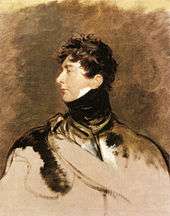
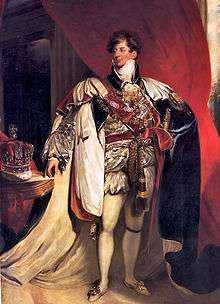
In late 1810, George III was once again overcome by his malady following the death of his youngest daughter, Princess Amelia. Parliament agreed to follow the precedent of 1788; without the King's consent, the Lord Chancellor affixed the Great Seal of the Realm to letters patent naming Lords Commissioners. The letters patent lacked the Royal Sign Manual, but were sealed by request of resolutions passed by both Houses of Parliament. The Lords Commissioners appointed by the letters patent, in the name of the King, then signified the granting of Royal Assent to a bill that became the Regency Act of 1811. Parliament restricted some of the powers of the Prince Regent (as the Prince of Wales became known). The constraints expired one year after the passage of the Act.[36] The Prince of Wales became Prince Regent on 5 February 1811.[37]
The Regent let his ministers take full charge of government affairs, playing a far lesser role than his father. The principle that the prime minister was the person supported by a majority in the House of Commons, whether the king personally favoured him or not, became established.[38] His governments, with little help from the Regent, presided over British policy. One of the most important political conflicts facing the country concerned Catholic emancipation, the movement to relieve Roman Catholics of various political disabilities. The Tories, led by the Prime Minister, Spencer Perceval, were opposed to Catholic emancipation, while the Whigs supported it. At the beginning of the Regency, the Prince of Wales was expected to support the Whig leader, William Grenville, 1st Baron Grenville. He did not, however, immediately put Lord Grenville and the Whigs into office. Influenced by his mother, he claimed that a sudden dismissal of the Tory government would exact too great a toll on the health of the King (a steadfast supporter of the Tories), thereby eliminating any chance of a recovery.[39]
In 1812, when it appeared highly unlikely that the King would recover, the Prince of Wales again failed to appoint a new Whig administration. Instead, he asked the Whigs to join the existing ministry under Perceval. The Whigs, however, refused to co-operate because of disagreements over Catholic emancipation. Grudgingly, the Prince of Wales allowed Perceval to continue as Prime Minister.[40]
On 10 May 1812, Perceval was assassinated by John Bellingham. The Prince Regent was prepared to reappoint all the members of the Perceval ministry under a new leader. The House of Commons formally declared its desire for a "strong and efficient administration",[41] so the Prince Regent then offered leadership of the government to Richard Wellesley, 1st Marquess Wellesley, and afterwards to Francis Rawdon-Hastings, 2nd Earl of Moira. He doomed the attempts of both to failure, however, by forcing each to construct an all party ministry at a time when neither party wished to share power with the other. Possibly using the failure of the two peers as a pretext, the Prince Regent immediately reappointed the Perceval administration, with Robert Jenkinson, 2nd Earl of Liverpool, as Prime Minister.[42]
The Tories, unlike Whigs such as Earl Grey, sought to continue the vigorous prosecution of the war in Continental Europe against the powerful and aggressive Emperor of the French, Napoleon I.[43] An anti-French alliance, which included Russia, Prussia, Austria, Britain and several smaller countries, defeated Napoleon in 1814. In the subsequent Congress of Vienna, it was decided that the Electorate of Hanover, a state that had shared a monarch with Britain since 1714, would be raised to a kingdom, known as the Kingdom of Hanover. On 30 December 1814, the Prince Regent signed and ratified the Treaty of Ghent which ended the War of 1812 with the United States. Napoleon returned from exile in 1815, but was defeated at the Battle of Waterloo by Arthur Wellesley, 1st Duke of Wellington, brother of Marquess Wellesley.
During this period George took an active interest in matters of style and taste, and his associates such as the dandy Beau Brummell and the architect John Nash created the Regency style. In London Nash designed the Regency terraces of Regent's Park and Regent Street. George took up the new idea of the seaside spa and had the Brighton Pavilion developed as a fantastical seaside palace, adapted by Nash in the "Indian Gothic" style inspired loosely by the Taj Mahal, with extravagant "Indian" and "Chinese" interiors.[44]
Reign
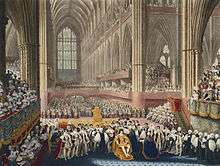
When George III died in 1820, the Prince Regent, then aged 57, ascended the throne as George IV, with no real change in his powers.[45] By the time of his accession, he was obese and possibly addicted to laudanum.[5]
George IV's relationship with his wife Caroline had deteriorated by the time of his accession. They had lived separately since 1796, and both were having affairs. In 1814, Caroline left the United Kingdom for continental Europe, but she chose to return for her husband's coronation, and to publicly assert her rights as queen consort. However, George IV refused to recognise Caroline as Queen, and commanded British ambassadors to ensure that monarchs in foreign courts did the same. By royal command, Caroline's name was omitted from the Book of Common Prayer, the liturgy of the Church of England.
The King sought a divorce, but his advisors suggested that any divorce proceedings might involve the publication of details relating to the King's own adulterous relationships. Therefore, he requested and ensured the introduction of the Pains and Penalties Bill, under which Parliament could have imposed legal penalties without a trial in a court of law. The bill would have annulled the marriage and stripped Caroline of the title of Queen. The bill proved extremely unpopular with the public, and was withdrawn from Parliament. George IV decided, nonetheless, to exclude his wife from his coronation at Westminster Abbey, on 19 July 1821. Caroline fell ill that day and died on 7 August; during her final illness she often stated that she thought she had been poisoned.[46]

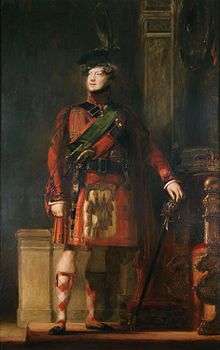
George's coronation was a magnificent and expensive affair, costing about £243,000 (approximately £19,970,000 in 2016;[6] for comparison, his father's coronation had only cost about £10,000, less than a twentieth of George IV's). Despite the enormous cost, it was a popular event.[5] In 1821 the King became the first monarch to pay a state visit to Ireland since Richard II of England.[47] The following year he visited Edinburgh for "one and twenty daft days".[48] His visit to Scotland, organised by Sir Walter Scott, was the first by a reigning British monarch since the mid-17th century.
George IV spent most of his later reign in seclusion at Windsor Castle,[49] but he continued to intervene in politics. At first it was believed that he would support Catholic emancipation, as he had proposed a Catholic Emancipation Bill for Ireland in 1797, but his anti-Catholic views became clear in 1813 when he privately canvassed against the ultimately defeated Catholic Relief Bill of 1813. By 1824 he was denouncing Catholic emancipation in public.[50] Having taken the coronation oath on his accession, George now argued that he had sworn to uphold the Protestant faith, and could not support any pro-Catholic measures.[51] The influence of the Crown was so great, and the will of the Tories under Prime Minister Lord Liverpool so strong, that Catholic emancipation seemed hopeless. In 1827, however, Lord Liverpool retired, to be replaced by the pro-emancipation Tory George Canning. When Canning entered office, the King, hitherto content with privately instructing his ministers on the Catholic Question, thought it fit to make a public declaration to the effect that his sentiments on the question were those of his revered father, George III.[52]
Canning's views on the Catholic Question were not well received by the most conservative Tories, including the Duke of Wellington. As a result, the ministry was forced to include Whigs.[53] Canning died later in that year, leaving Frederick Robinson, 1st Viscount Goderich, to lead the tenuous Tory-Whig coalition. Lord Goderich left office in 1828, to be succeeded by the Duke of Wellington, who had by that time accepted that the denial of some measure of relief to Roman Catholics was politically untenable.[54][55] George was never as friendly with Wellington as he had been with Canning and chose to annoy the Duke by pretending to have fought at Waterloo disguised as a German general. With great difficulty Wellington obtained the King's consent to the introduction of a Catholic Relief Bill on 29 January 1829. Under pressure from his fanatically anti-Catholic brother, the Duke of Cumberland, the King withdrew his approval and in protest the Cabinet resigned en masse on 4 March. The next day the King, now under intense political pressure, reluctantly agreed to the Bill and the ministry remained in power.[5] Royal Assent was finally granted to the Catholic Relief Act on 13 April.[56]
Decline and death
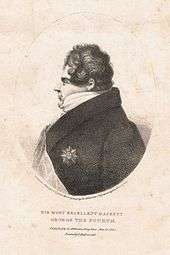
George's heavy drinking and indulgent lifestyle had taken their toll on his health by the late 1820s. While still Prince of Wales, he had become obese through his huge banquets and copious consumption of alcohol, making him the target of ridicule on the rare occasions that he appeared in public;[57] by 1797 his weight had reached 17 stone 7 pounds (111 kg; 245 lb).[58] By 1824, his corset was made for a waist of 50 inches (130 cm).[59] He suffered from gout, arteriosclerosis, peripheral edema ("dropsy"), and possibly porphyria. In his last years, he spent whole days in bed and suffered spasms of breathlessness that would leave him half-asphyxiated.[5]
By December 1828, like his father, George was almost completely blind from cataracts, and was suffering from such severe gout in his right hand and arm that he could no longer sign documents.[60] In mid-1829, Sir David Wilkie reported the King "was wasting away frightfully day after day", and had become so obese that he looked "like a great sausage stuffed into the covering".[61] The King took laudanum to counteract severe bladder pains, which left him in a drugged and mentally handicapped state for days on end.[62] In 1830 his weight was recorded to be 20 stone (130 kg; 280 lb).[63]
By the spring of 1830, George's imminent end was apparent. Attacks of breathlessness due to dropsy forced him to sleep upright in a chair, and doctors frequently tapped his abdomen to drain excess fluid.[62] He was admired for clinging doggedly to life despite his obvious decline.[64] He dictated his will in May and became very devout in his final months, confessing to an archdeacon that he repented of his early dissolute life, but hoped mercy would be shown to him as he had always tried to do the best for his subjects.[62] At about half-past three in the morning of 26 June 1830 at Windsor Castle, he reportedly called out "Good God, what is this?", clasped his page's hand, said "my boy, this is death", and died.[65] An autopsy conducted by his physicians revealed he had died from upper gastrointestinal bleeding resulting from the rupture of a blood vessel in his stomach.[66] A large tumour "the size of an orange" was found attached to his bladder, and he had an enlarged heart surrounded by a large fat deposit and heavily calcified heart valves.[66] He was buried in St George's Chapel, Windsor Castle, on 15 July.[67]
His only legitimate child, Princess Charlotte of Wales, had died from post-partum complications in 1817, after delivering a stillborn son. The second son of George III, Prince Frederick, Duke of York and Albany, had died childless in 1827, so the succession passed to the third son of George III, Prince William, Duke of Clarence, who reigned as William IV.[68]
Legacy
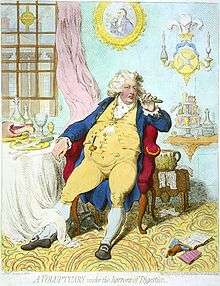
George's last years were marked by increasing physical and mental decay and withdrawal from public affairs. Privately a senior aide to the King confided to his diary: "A more contemptible, cowardly, selfish, unfeeling dog does not exist ... There have been good and wise kings but not many of them ... and this I believe to be one of the worst."[1] On his death The Times captured elite opinion succinctly: "There never was an individual less regretted by his fellow-creatures than this deceased king. What eye has wept for him? What heart has heaved one throb of unmercenary sorrow? ... If he ever had a friend – a devoted friend in any rank of life – we protest that the name of him or her never reached us."[69] George IV was described as the "First Gentleman of England" on account of his style and manners.[70] He possessed many good qualities; he was bright, clever, and knowledgeable. However, his laziness and gluttony led him to squander much of his talent. The Times wrote, he would always prefer "a girl and a bottle to politics and a sermon".[71]
The Regency period saw a shift in fashion that was largely determined by George. After political opponents put a tax on wig powder, he abandoned wearing a powdered wig in favour of natural hair.[72] He wore darker colours than had been previously fashionable as they helped to disguise his size, favoured pantaloons and trousers over knee breeches because they were looser, and popularised a high collar with neck cloth because it hid his double chin.[73] His visit to Scotland in 1822 led to the revival, if not the creation, of Scottish tartan dress as it is known today.[74]
During the political crisis caused by Catholic emancipation, the Duke of Wellington said that George was "the worst man he ever fell in with his whole life, the most selfish, the most false, the most ill-natured, the most entirely without one redeeming quality",[75] but his eulogy delivered in the House of Lords called George "the most accomplished man of his age" and praised his knowledge and talent.[76] Wellington's true feelings probably lie somewhere between these two extremes; as he said later, George was "a magnificent patron of the arts ... the most extraordinary compound of talent, wit, buffoonery, obstinacy, and good feeling—in short a medley of the most opposite qualities, with a great preponderence of good—that I ever saw in any character in my life."[76]
.jpg)
There are many statues of George IV, a large number of which were erected during his reign. In the United Kingdom, they include a bronze statue of him on horseback by Sir Francis Chantrey in Trafalgar Square and another outside the Royal Pavilion in Brighton.
In Edinburgh, "George IV Bridge" is a main street linking the Old Town High Street to the north over the ravine of the Cowgate, designed by the architect Thomas Hamilton in 1829 and completed in 1835. King's Cross, now a major transport hub sitting on the border of Camden and Islington in north London, takes its name from a short-lived monument erected to George IV in the early 1830s.[77] A square and a neighbouring park in St Luke's, Islington, are also named after George IV.[78]
Titles, styles, honours and arms
Titles and styles
- 12 August 1762 – 29 January 1820: His Royal Highness The Duke of Cornwall
- 19 August 1762 – 29 January 1820: His Royal Highness The Prince of Wales
- 5 February 1811 – 29 January 1820: His Royal Highness The Prince Regent
- 1 October 1814 – 29 January 1820: His Royal Highness The Crown Prince of Hanover
- 29 January 1820 – 26 June 1830: His Majesty The King
At birth, he was also entitled to the dignities Prince of Great Britain, Electoral Prince of Brunswick-Lüneburg and Duke of Rothesay.[79] Under the Act of Parliament that instituted the regency, the prince's formal title as regent was "Regent of the United Kingdom of Great Britain and Ireland".[80]
Honours
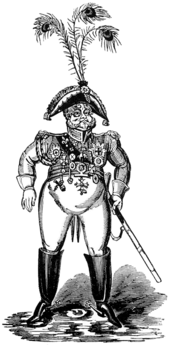
British honours
- 26 December 1765: Knight of the Garter[79]
- 21 November 1783: Privy Counsellor[79]
- 26 January 1789: Fellow of the Royal Society[79]
- 2 May 1810: Doctor of Civil Law, University of Oxford[79]
Foreign honours
- 25 November 1813: Knight of St Andrew (Russia)[79]
- 20 April 1814: Knight of St Alexander Nevski (Russia)[79]
- 20 April 1814: Knight of the Holy Spirit (France)[79]
- 4 July 1815: Knight of the Elephant (Denmark)[81]
- July 1815: Knight of the Golden Fleece (Austria)[79]
- 27 November 1818: Grand Cross of the Military William Order (Netherlands)[82]
Military appointments
- 1782: Colonel, British Army[79]
- 1796–1820: Colonel of the 10th Light Dragoons[79]
Arms
As Prince of Wales, George Augustus bore the royal arms (with an inescutcheon of Gules plain in the Hanoverian quarter), differenced by a label of three points Argent.[83] The arms included the royal crest and supporters but with the single arched coronet of his rank, all charged on the shoulder with a similar label. His arms followed the change in the royal arms in 1801, when the Hanoverian quarter became an inescutcheon and the French quarter was dropped altogether.[84] The 1816 alteration did not affect him as it only applied to the arms of the King.[85]
As king his arms were those of his two kingdoms, the United Kingdom and Hanover, superimposed: Quarterly, I and IV Gules three lions passant guardant in pale Or (for England); II Or a lion rampant within a double tressure flory-counter-flory Gules (for Scotland); III Azure a harp Or stringed Argent (for Ireland); overall an escutcheon tierced in pall reversed (for Hanover), I Gules two lions passant guardant Or (for Brunswick), II Or a semy of hearts Gules a lion rampant Azure (for Lüneburg), III Gules a horse courant Argent (for Westphalia), overall an inescutcheon Gules charged with the crown of Charlemagne Or, the whole escutcheon surmounted by a crown.[86]
.svg.png) |
.svg.png) |
.svg.png) |
.svg.png) |
|---|---|---|---|
Ancestry
Notes and sources
- 1 2 Baker, Kenneth (2005). "George IV: a Sketch". History Today. 55 (10): 30–36.
- ↑ Smith, E. A., p.1
- ↑ Smith, E. A., p.2
- ↑ Hibbert, George IV: Prince of Wales 1762–1811, p.2
- 1 2 3 4 5 6 Hibbert, Christopher (2004). "George IV (1762–1830)". Oxford Dictionary of National Biography. Oxford University Press.
- 1 2 3 4 5 6 7 8 UK CPI inflation numbers based on data available from Gregory Clark (2016), "The Annual RPI and Average Earnings for Britain, 1209 to Present (New Series)" MeasuringWorth.
- ↑ Smith, E. A., pp.25–28
- ↑ Smith, E. A., p.48
- ↑ Smith, E. A., p.33
- ↑ Smith, E. A., pp.36–38
- ↑ David, pp.57–91
- 1 2 3 4 Innes, Arthur Donald (1914). A History of England and the British Empire, Vol. 3. The MacMillan Company. pp. 396–397.
- ↑ De-la-Noy, p.31
- 1 2 Marilyn Morris, "Princely Debt, Public Credit, and Commercial Values in Late Georgian Britain." Journal of British Studies 2004 43(3): 339–365
- ↑ Röhl, J.C.G.; Warren, M.; Hunt, D. (1998). Purple Secret. Bantam Press.
- ↑ Peters TJ, Wilkinson D (2010). "King George III and porphyria: a clinical re-examination of the historical evidence". History of Psychiatry. 21 (81 Pt 1): 3–19. doi:10.1177/0957154X09102616. PMID 21877427.
- 1 2 3 4 David, pp.92–119
- ↑ Smith, E. A., p.54
- ↑ Derry, p.71
- ↑ Derry, p.91
- 1 2 May, Thomas Erskine (1896). The Constitutional History of England Since the Accession of George the Third, 1760–1860 (11th ed.). London: Longmans, Green and Co. chapter III pp.184–95.
- 1 2 Derry, p.109
- ↑ Derry, p.181
- ↑ Smith, E. A., p.70
- 1 2 David, pp.150–205
- ↑ Parissien, p.60
- ↑ Hibbert, George IV: Prince of Wales 1762–1811, p.18
- ↑ Hibbert, George IV: Regent and King 1811–1830, p.214
- ↑ David, pp.76–78
- ↑ David, p.78
- ↑ David, p. 80
- ↑ Camp, Anthony J. (2007) Royal Mistresses and Bastards: Fact and Fiction 1714–1936, ISBN 978-0-9503308-2-2
- ↑ De-la-Noy, p.55
- ↑ Smith, E. A., p.97
- ↑ Ashley, Mike (1998). The Mammoth Book of British Kings and Queens. London: Robinson. p. 684. ISBN 1-84119-096-9.
- ↑ Innes, Arthur Donald (1915). A History of England and the British Empire, Vol. 4. The MacMillan Company. p. 50.
- ↑ The London Gazette: no. 16451. p. 233. 5 February 1811.
- ↑ Bagehot, Walter (1872) The English constitution, p. 247
- ↑ Parissien, p.185
- ↑ Smith, E. A., pp.141–2
- ↑ Smith, E. A., p.144
- ↑ Smith, E. A., p.145
- ↑ Smith, E. A., p.146
- ↑ Rutherford, Jessica M. F. (1995). The Royal Pavilion: The Palace of George IV. Brighton Borough Council. p. 81. ISBN 0-948723-21-1.
- ↑ Innes, Arthur Donald (1915). A History of England and the British Empire, Vol. 4. The MacMillan Company. p. 81.
- ↑ Innes, Arthur Donald (1915). A History of England and the British Empire, Vol. 4. The MacMillan Company. p. 82.
- ↑ De-la-Noy, p.95
- ↑ Prebble, John (2000). The King's Jaunt: George IV in Scotland, 1822. Edinburgh: Birlinn Limited. ISBN 1-84158-068-6.
- ↑ "King George IV". Official website of the British monarchy. Retrieved 18 April 2016.
- ↑ Parissien, p.189
- ↑ Smith, E. A., p.238
- ↑ Hibbert, George IV: Regent and King 1811–1830, p.292
- ↑ Smith, E. A., pp.231–4
- ↑ Parissien, p.190
- ↑ Smith, E. A., p.237
- ↑ Parissien, p.381
- ↑ Parissien, p.355
- ↑ De-la-Noy, p.43
- ↑ Parissien, p.171
- ↑ Smith, E. A., pp.266–67
- ↑ Smith, E. A., p.266-67
- 1 2 3 Smith, E. A., p.269
- ↑ Baker, Kenneth (2005). George IV: a life in caricature. Hudson and Thames. p. 202. ISBN 978-0-500-25127-0.
- ↑ Smith, E. A., p.270
- ↑ De-la-Noy, p.103; Smith, E. A., p.271
- 1 2 Smith, E. A., p.275
- ↑ Hibbert, George IV: Regent and King 1811–1830, p.336
- ↑ Innes, Arthur Donald (1915). A History of England and the British Empire, Vol. 4. The MacMillan Company. p. 105.
- ↑ The Times (London) 15 July 1830 quoted in Hibbert, George IV: Regent and King 1811–1830, p. 342
- ↑ The Diary of Prince Pückler-Muskau (May 1828). Quoted in Parissien, p.420
- ↑ Clarke, John (1975). "George IV". The Lives of the Kings and Queens of England. Knopf: 225.
- ↑ Parissien, p. 112
- ↑ Parissien, p.114
- ↑ Parissien, pp. 324–26
- ↑ Hibbert, George IV: Regent and King 1811–1830, p.310
- 1 2 Hibbert, George IV: Regent and King 1811–1830, p.344
- ↑ "Camden's history". Camden Council. Retrieved 5 March 2007.
- ↑ "History". St Clement's Church, King Square. Retrieved 3 April 2015.
- 1 2 3 4 5 6 7 8 9 10 11 Cokayne, G. E. (1910), Gibbs, Vicary, ed., The complete peerage of England, Scotland, Ireland, Great Britain and the United Kingdom, 4, London: St Catherine's Press, pp. 450–451
- ↑ Hibbert, George IV: Prince of Wales 1762–1811, p.280
- ↑ Jørgen Pedersen (2009). Riddere af Elefantordenen, 1559–2009 (in Danish). Syddansk Universitetsforlag. p. 207. ISBN 978-87-7674-434-2.
- ↑ "Militaire Willems-Orde: Wales, George Augustus Frederick, Prince of" [Military William Order: Wales, George Augustus Frederick, Prince of] (in Dutch). Ministerie van Defensie. Retrieved 12 March 2016.
- ↑ Francois R. Velde. "Heraldica – British Royalty Cadency". Heraldica.org. Retrieved 11 May 2013.
- ↑ The London Gazette: no. 15324. p. 2. 30 December 1800.
- ↑ Pinches, John Harvey; Pinches, Rosemary (1974). The Royal Heraldry of England. Heraldry Today. Slough, Buckinghamshire: Hollen Street Press. pp. 228–229. ISBN 0-900455-25-X.
- ↑ The London Gazette: no. 17149. p. 1237. 29 June 1816.
References and further reading
- Baker, Kenneth (2005). "George IV: a Sketch". History Today. 55 (10): 30–36.
- Baker, Kenneth (2005). George IV: A Life in Caricature. London: Thames & Hudson. ISBN 0-500-25127-4.
- David, Saul (2000). Prince of Pleasure: The Prince of Wales and the Making of the Regency. Grove Press. ISBN 0-8021-3703-2.
- De-la-Noy, Michael (1998). George IV. Stroud, Gloucestershire: Sutton Publishing. ISBN 0-7509-1821-7.
- Derry, John W. (1963). The Regency Crisis and the Whigs. Cambridge University Press.
- Hibbert, Christopher (1972). George IV, Prince of Wales, 1762–1811. London: Longman. ISBN 0-582-12675-4.
- Hibbert, Christopher (1973). George IV, Regent and King, 1811–1830. London: Allen Lane. ISBN 0-7139-0487-9.
- Hibbert, Christopher (2008) [2004]. "George IV (1762–1830)". Oxford Dictionary of National Biography (online ed.). Oxford University Press. (subscription or UK public library membership required)
- Machin, G. I. T. (1964). The Catholic Question in English Politics 1820 to 1830. Oxford: Oxford University Press.
- Parissien, Steven (2001). George IV: The Grand Entertainment. London: John Murray. ISBN 0-7195-5652-X.
- Priestley, J. B. (1969). The Prince of Pleasure and His Regency (1811–20). London: Heinemann. ISBN 978-0-434-60357-2.
- Smith, E. A. (1999). George IV. Yale University Press. ISBN 0-300-07685-1.
- Smith, E. A. (2008) [2004]. "Caroline (1768–1821)". Oxford Dictionary of National Biography (online ed.). (subscription or UK public library membership required)
External links
| Simple English Wikiquote has a collection of quotations related to: George IV of the United Kingdom |
 Media related to George IV of the United Kingdom at Wikimedia Commons
Media related to George IV of the United Kingdom at Wikimedia Commons- "Archival material relating to George IV of the United Kingdom". UK National Archives.
- Portraits of King George IV at the National Portrait Gallery, London

| George IV of the United Kingdom Cadet branch of the House of Welf Born: 12 August 1762 Died: 26 June 1830 | ||
| Regnal titles | ||
|---|---|---|
| Preceded by George III |
King of the United Kingdom and Hanover 29 January 1820 – 26 June 1830 |
Succeeded by William IV |
| British royalty | ||
| Vacant Title last held by Prince George, Duke of Edinburghlater became King George III |
Prince of Wales 1762–1820 |
Vacant Title next held by Prince Albert Edwardlater became King Edward VII |
| Vacant Title last held by Frederick, Prince of Wales |
Duke of Cornwall Duke of Rothesay 1762–1820 | |
| Military offices | ||
| Preceded by Sir William Augustus Pitt |
Colonel of the 10th (The Prince of Wales's Own) Royal Regiment of (Light) Dragoons (Hussars) 1796–1820 |
Succeeded by The Lord Stewart |
| Masonic offices | ||
| Preceded by The Duke of Cumberland |
Grand Master of the Premier Grand Lodge of England 1790–1813 |
Succeeded by The Duke of Sussex |
| Other offices | ||
| Preceded by The Duke of Portland |
President of the Foundling Hospital 1809–1820 |
Succeeded by The Duke of York |

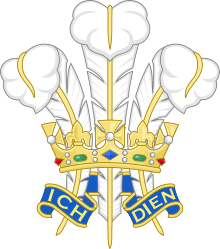


.svg.png)

